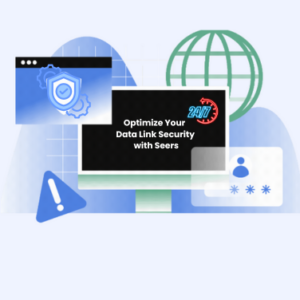In technology, you will come across the term Data Link, especially in companies or structures which deal with communication setups. In simple language, a data link refers to the connection of one area to another.
At Seers, we understand the critical role that data link technology plays in ensuring seamless communication and data transfer. As businesses increasingly rely on robust digital infrastructures, understanding how data links function is essential for maintaining effective and secure connectivity.
Transform your data link strategy with Seers.

- Robust Encryption
- Real-Time Monitoring
- Error Detection
- Custom Solutions.
- Streamlined Implementation
- 24/7 Support
Want to optimise your data link management?
The main aim of these connections is to send or receive digital information. There is a special link protocol that enables the transfer of these waves, which then get interpreted on the receiving computer. In Open Systems Interconnection (OSI), the data link incorporates the second layer. This layer is involved in transferring data and correcting any errors in the first layer – the physical layer. How does data link work? Please read to find out more about the data link and how it functions.
Details about data link
Datalink establishes a connection between two devices, most commonly the computers. The device can send and receive the data concurrently. Data links get configured in three different ways. These include the simplex connection, half-duplex, and the full-duplex connection.
Simplex communication only does unidirectional communication, while half-duplex can offer simultaneous bidirectional communication. Lastly and the most effective data link is the full-duplex connection. This full-duplex digital communication is the most sophisticated one which does bidirectional communication simultaneously.
Some protocols govern the transfer of this data from one device to another. There has to be a proper link between the two devices to ensure effective communication. Organizations often collaborate with technology experts, such as a python development firm, to integrate data link solutions effectively within their software ecosystems, ensuring robust and seamless communication.
Sublayers of Datalink Layer
In general, Datalink comprises two sub-layers. These include the Logical Link Control (LLC) and the Media Access Control (MAC). Here are the details.
- Logical Link Control (LLC): This is the upper sublayer and normally consists of protocols running at the top of the Data Link layer. This layer provides control, acknowledgement, error notification, and flow control in transferring data. The LLC’s main function is to address and control the data link. It specifies the methods required to address the transmission channels and controls how data gets transferred from the packet generator to the recipient of the data.
- Media Access Control (MAC): This layer determines who can access the data at any given time. The MAC ensures the receiver gets the message to the required address on time. When it sends the message, the Address Resolution Protocol (ARP) asks for the IP address owner. The destination host needs to reply with the MAC address which gives in the address, allowing the message to its right destination.
Functions of the Data Link Layers
Datalink has several uses in the technological world. These functions include the below:
- Framing: The data link layer receives a different stream from the network then divides the same into manageable data units. These units are referred to as frames.
- Physical Addressing: When these frames get redistributed to other networks, data link layers determine the sender’s physical address and the receiver’s address. It then adds a header on the addresses. When the frame is the recipient outside the network, the recipient changes to the device that connects to the other network. Datalink layers play a huge role in interlinking all these to allow better communication between networks.
- Flow Control: Sometimes, the data consumed by the receiver is less than the one sent. Data Link layers enable the control of these data from the sender to the recipient to avoid overrunning the receiver or losing data between the sender and the recipient.
- Error Control: At times, there are damaged or lost frames in data transmission. Datalink layers have mechanisms to detect and transmit lost packets to increase communication reliability.
- Access Control: When you have two devices interconnected, it’s the data link layers that determine which device controls the other. It determines the type of device which gets a control link in data transmission.
- Link Management: For an effective exchange of data to occur, there has to be coordination and cooperation between the sender and the recipient. Datalink layers initiate, manage and terminate the links when data is transferred to enable smooth data transmission. The layers ensure protocols are followed during data transfer.
There are different devices used in different transmission areas to enable smooth transmission of data. These include the Enhanced Micro Data Link System (EMDLS), Integrated Data Link System (IDLS), and the Advanced Mini Link System (AMLS). There are also the Advanced Analogue or Digital Data Link systems.
All these have different uses, and it’s important to seek expert advice on their installation and use. This article has explained in detail what Data Link is, its layers, and the functions. Experts recommend getting a professional IT company to help you implement this if running a company or any other technology business that requires the data link services.
In conclusion, while data links are fundamental to efficient data transfer and communication, partnering with Seers can further enhance your data protection and compliance efforts. Our solutions are designed to ensure that your data links are not only functional but also secure and compliant with industry standards.
